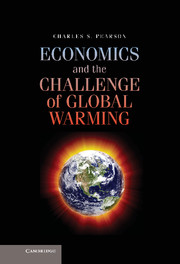Book contents
- Frontmatter
- Contents
- Acknowledgments
- Introduction and a Road Map
- 1 Climate Change
- 2 The Role of Benefit Cost in Climate Policy
- 3 Discounting and Social Weighting (Aggregating over Time and Space)
- 4 Empirical Estimates
- 5 Strategic Responses
- 6 Targets and Tools
- 7 Trade and Global Warming
- 8 The Challenge of International Cooperation
- 9 Beyond Kyoto
- 10 A Summing-Up
- Index
- References
4 - Empirical Estimates
A Tasting Menu
Published online by Cambridge University Press: 05 June 2012
- Frontmatter
- Contents
- Acknowledgments
- Introduction and a Road Map
- 1 Climate Change
- 2 The Role of Benefit Cost in Climate Policy
- 3 Discounting and Social Weighting (Aggregating over Time and Space)
- 4 Empirical Estimates
- 5 Strategic Responses
- 6 Targets and Tools
- 7 Trade and Global Warming
- 8 The Challenge of International Cooperation
- 9 Beyond Kyoto
- 10 A Summing-Up
- Index
- References
Summary
This chapter describes how numbers used in benefit cost (BC) analysis materialize and are assembled. They are not simply plucked from the air, but they are not as solid as we would like, either. Our purpose is not an exhaustive description, but rather to convey the flavor of the process. We start with a brief introduction to Integrated Assessment Models (IAMs), the main tool for empirical investigation of climate policy. At the center of IAMs are damage functions that identify the impacts of climate change and attempt to put monetary values on them. Damage functions are the spline that joins the science and economics of climate change. We then dig down one level to understand where the numbers in two specific impact areas, agriculture and sea-level rise, come from. The costs of global warming include adapting to higher temperatures as well as residual damages. We continue by reviewing some recent attempts to estimate adaptation costs. Finally we look into a specific proposed response to global warming – forestry policy – from the perspective of BC analysis.
Integrated Assessment Models
All climate IAMs have two basic features. They are designed to illuminate the interconnected physical, biological, and socioeconomic elements of climate change. They are also designed to assist in policy formation. IAMs come in two flavors: policy evaluation models (simulation models), and optimization models. The first assesses the physical, ecological, or economic effects of an exogenously proposed climate policy. The second seeks out an endogenously derived optimal policy to maximize welfare or minimize cost. Optimization models generally are less detailed and less complex than policy evaluation models so as not to exceed computational constraints. While simplification involves a cost, it assists in transparency and understanding.
- Type
- Chapter
- Information
- Economics and the Challenge of Global Warming , pp. 73 - 96Publisher: Cambridge University PressPrint publication year: 2011



